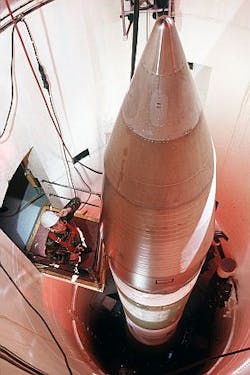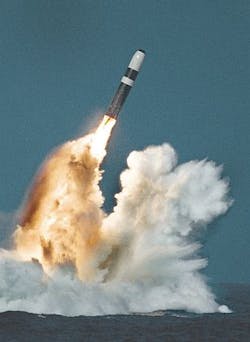Nuclear ballistic missile command and control technology still a prime military concern
SPECIAL REPORT, 7 Feb. 2011. No one is indifferent when it comes to nuclear-tipped intercontinental ballistic missiles (ICBMs). These doomsday weapons represent one of the most politically volatile and emotional issues people have faced for more than half a century. These weapons are scary, and it’s not hard to see why. Each missile can deliver about 10 times the destructive power of the bombs dropped in 1945 on Hiroshima and Nagasaki. Some of these missiles also carry multiple independently targetable re-entry vehicles (MIRVs), which increases their destructive power. The very existence of these weapons has induced ordinary citizens to build underground shelters in their backyards, was behind the "duck-and-cover" drop drills in public schools at the height of the Cold War, and sparked countless public protests since the 1960s.
For more on ballistic missile guidance and battle management, see related story entitled Command and control of intercontinental ballistic missiles.
Nevertheless, ballistic missiles represent the two most important legs of U.S. nuclear strategy, which is the traditional "nuclear triad" of land-based bomber aircraft, ICBMs, and submarine-launched ballistic missiles (SLBMs). The land- and sea-based ballistic missiles offer the big punch, are more hardened against enemy attack than the bombers are, and can be launched at their targets from thousands of miles away. Still, the long distances to their targets and the challenging environment of ocean-going submarines makes ballistic missile-guidance and command-and-control technologies for aiming and directing ballistic missiles a daunting challenge.
Scary or not, nuclear missiles are as essential today for helping maintain the global balance of military power as they were during the Cold War, and arguably have helped prevent huge military confrontations since World War II. Supporters of global nuclear disarmament contend that nuclear weapons and their delivery systems are obsolete today, relics of a bygone era when the United States and then-Soviet Union were the undisputed world powers. The existence of nuclear missiles, however, still deters aggression, and forms the last line of defense during dire global military contingencies.
ICBM guidance systems
The ability to guide, control, and command the nuclear missile force is still a primary concern among U.S. military planners, despite treaties and cutbacks that have reduced the U.S. nuclear arsenal by about 75 percent since the end of the Cold War in the early 1990s. No one wants a force this powerful to be loosely controlled or less than accurate. That's the reason for a reliable command structure for the nuclear missile force (see accompanying story: Command and control of intercontinental ballistic missiles) and precise guidance systems for the ballistic missiles themselves.
Today the guidance systems for land- and sea-based ballistic missiles rely in inertial technology -- precise gyros that keep the missiles on their glide paths, periodically updated by on-board celestial navigation subsystems that watch the stars to make sure the inertial systems are functioning accurately.
Advanced navigation systems, such as the satellite-based Global Positioning System (GPS), have been considered for upgrades to the nuclear ballistic missile force, but as yet have not been adopted. Nevertheless, advanced technologies such as fiber-optic gyros (FOGs) over the years have been inserted into the ballistic missile force to keep their guidance systems as reliable and accurate as possible.
One problem with upgrading the nation's ballistic missile force has been a relative lack of money. Generally it's a political loser for the president of the United States, Congress, or the Pentagon to push hard for upgrading the missile force. Nuclear weapons, after all, are an unpopular topic, and few in the public eye step forward to champion their improvement.
Arms-reduction treaties
Treaties have been in place since 1969 that compelled the reduction of U.S. nuclear warhead stockpiles. The U.S. inventory of nuclear warheads peaked in 1966 at 32,193 warheads. Notable treaties between the U.S. and Russia include the START II treaty, which although it never actually was put into force, led to major changes in the U.S. nuclear arsenal. START II, short for the second Strategic Arms Reduction Treaty, called for banning the use of MIRV warheads on land-based ICBMs.
In 2002 the U.S. on its own started withdrawing MIRV ICBMs from service, which included the complete deactivation of the LGM-118 Peacekeeper missile -- popularly known as the MX. Each Peacekeeper missile was designed to carry as many as 10 separate warheads, making this system one of the most destructive weapons ever deployed. These missiles started entering service in 1986, and 50 of these missiles eventually were deployed. Largely due to START II, however, the U.S. started deactivating these missiles in 2002, and took the last one out of service in 2005. The Peacekeeper nuclear warheads, however, were retained. Russia reportedly still has from 40 to 75 R-36M2 ICBMs in service, each with 10 MIRV warheads apiece.
The Strategic Offensive Reduction Treaty (SORT) was in place between the U.S. and Russia from 2003 to just last year, and called for the two countries to limit their nuclear arsenals to between 1,700 and 2,200 operationally deployed warheads each. The latest nuclear-arms reduction treaty is New Strategic Arms Reduction Treaty, or New START, which was signed in April 2010 and should be in place until early 2021. New START seeks to reduce the number of strategic nuclear missile launchers by half, does not limit the number of inactive stockpiled nuclear warheads, and does not place limitations on MIRV warheads. New START further limits the number of U.S. and Russian deployed strategic nuclear warheads in 1,550 each. It would limit the number of ICBMs, SLBMs, and heavy bombers that carry nuclear weapons to 700 in each country.
Minuteman-III ICBM
Largely due to these treaties, U.S. military leaders look to maintain and upgrade their best ballistic missile systems for the long term. The only land-based ICBM the U.S. keeps on active deployment is the LGM-30G Minuteman-III. Previous versions of this missile -- the Minuteman-I and Minuteman-II -- were in service from 1962 to 1997. First deployed in 1970, the Minuteman-III ICBM guidance is based on a gimbaled inertial guidance system. Although the Minuteman-III carries only one warhead per missile, it is capable of carrying three MIRV warheads.
The Minuteman-III originally was equipped with a Rockwell Autonetics D37D flight computer, but as of 2008 has been upgraded as part of the Minuteman-III Guidance Replacement Program (GRP). The Boeing Co. acquired Rockwell Autonetics in 1996, and the Boeing Integrated Defense Systems segment in Heath, Ohio, was in charge of the GRP initiative. Boeing experts installed the NS-50 missile guidance computer (MGC) based on a 16-bit high-speed microprocessor, which helps the missile correct positional errors and generate steering signals.
Minuteman-III computer programs are stored on a magnetic tape cartridge. The computer also controls the alignment of the inertial measurement unit, and performs test and monitoring of the missile's guidance & control system. Other parts of the Minuteman-III's latest guidance system include the Gyro Stabilized Platform (GSP), Digital Control Unit (DCU), Missile Guidance Set Control (MGSC), and the Amplifier Assembly.
Trident II D-5 SLBM
The UGM-133 Trident II D-5 is the primary U.S. sea-based nuclear ballistic missile, and is deployed aboard U.S. Navy Ohio-class ballistic missile submarines. The Navy operates 14 of these ballistic missile submarines, each of which can carry as many as 24 Trident II ballistic missiles. Although the Trident II is designed to carry as many as 12 MIRV warheads, current treaties reduce this number to four or five. Each missile has a range of 4,000 to 7,000 miles. The Trident II D-5 was first deployed in 1990 and is scheduled to remain in service until at least 2027.
In practice, the Trident II missile's inertial measurement system receives targeting data from computers aboard the submarine. The inertial measurement unit, in turn, transmits signals to the D-5 flight-control computer and converts them into steering commands to keep the ballistic missile on target. Its post-boost control system maneuvers the missile in flight to observe stars for the missile's celestial navigation subsystem, which updates the inertial system in flight.
Draper Lab received a $130.6 million contract in late 2005 to maintain and improve the Trident II's MK-6 guidance system. Awarding the contract were officials of the Navy Systems Programs office in Washington, which is in charge of Navy ballistic missile technology. In that effort Draper Lab experts developed an open-architecture strategic inertial guidance technology synthesizer to help them evaluate alternatives to the missile's gyroscope, and appropriate radiation-hardened electronics for the missile.
One year later, Draper Lab received another Navy contract to repair and recertify the Trident II's MK-6 guidance system, including its pendulous integrating gyroscopic accelerometers, inertial measurement units, electronic assemblies, and inertial measurement unit electronics. In February 2010, Draper Lab started work to acquire circuit card assemblies for the Trident II guidance system as a part of the MK-6 life-extension program.
As part of the Trident II guidance system life-extension program, Draper Lab experts went to Nufern in East Granby, Conn., to provide rugged optical fiber for use in the Trident II's guidance system. Nufern is the lead optical fiber supplier supporting Trident II upgrades, and supplies Honeywell Inc. to develop optical fiber for the Trident II missile's fiber-optic gyroscope.

